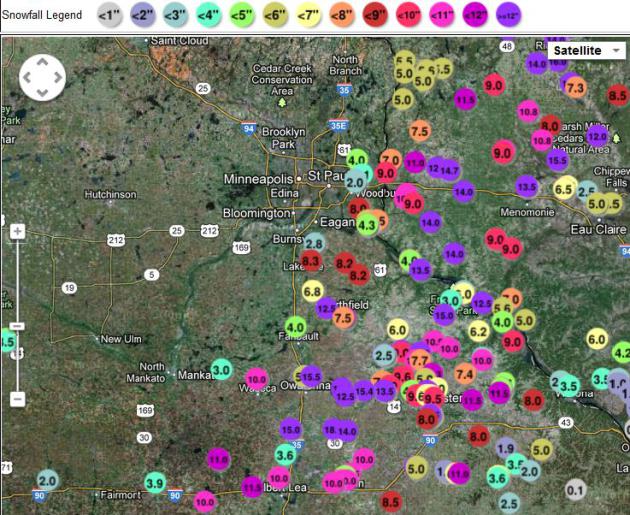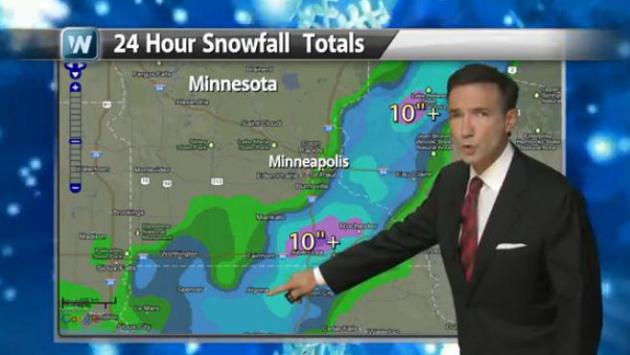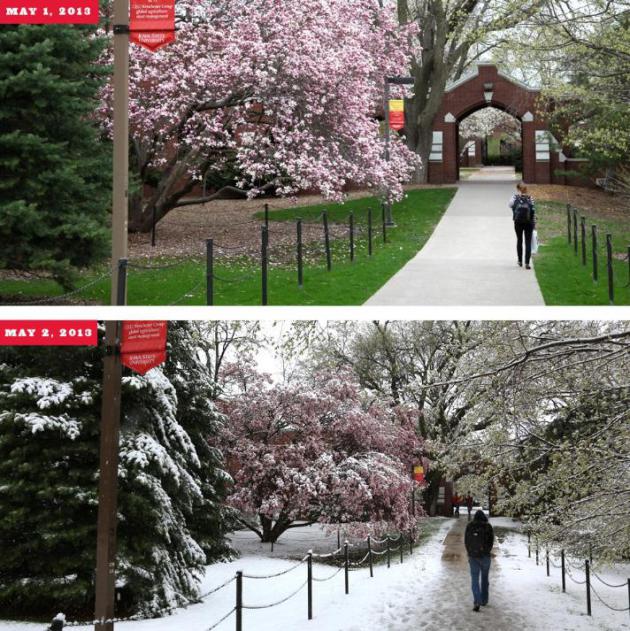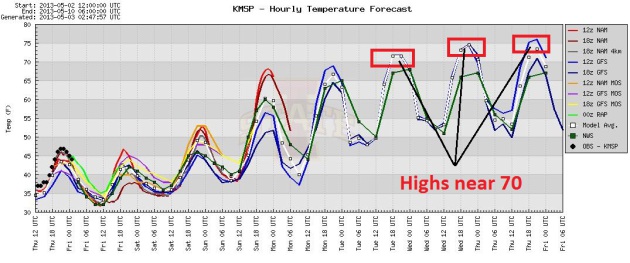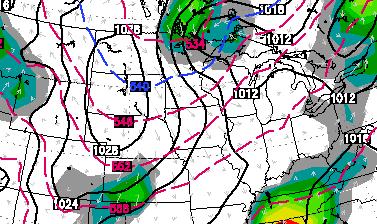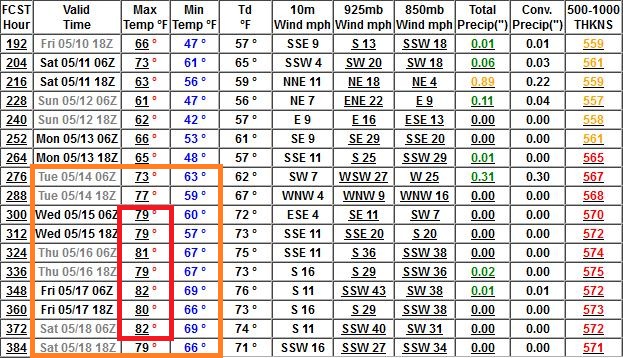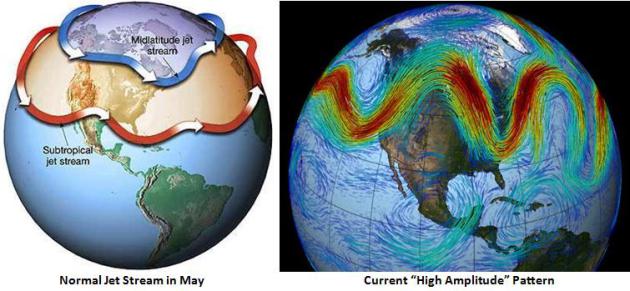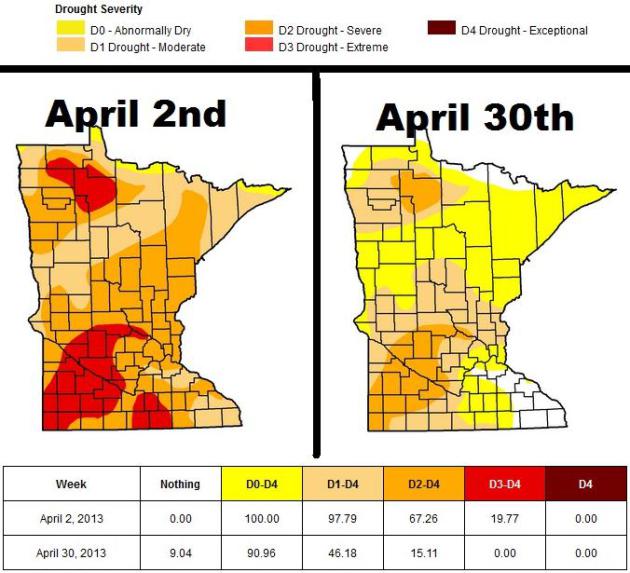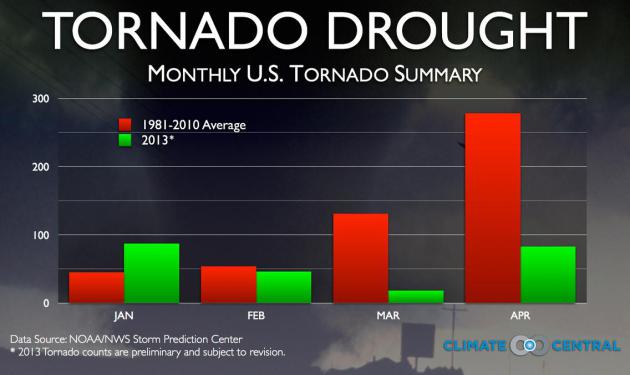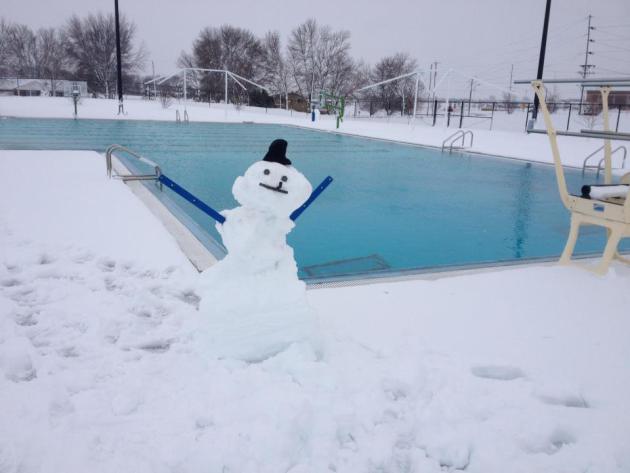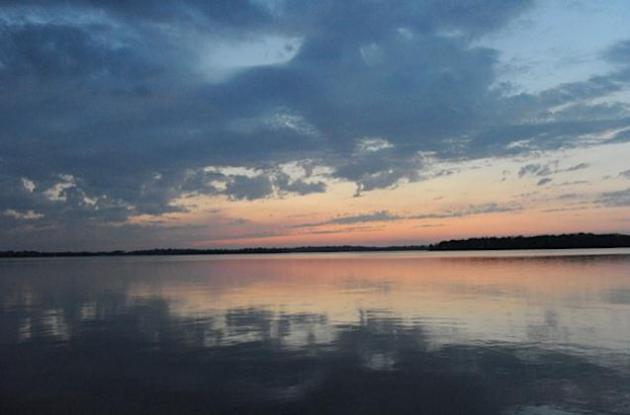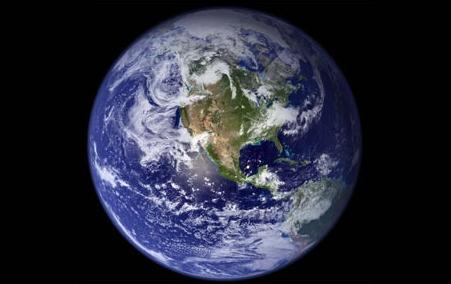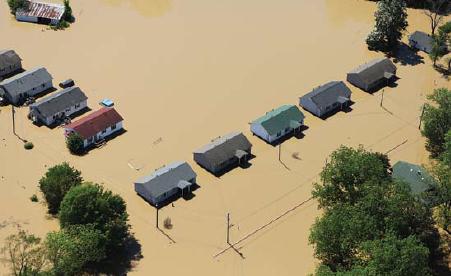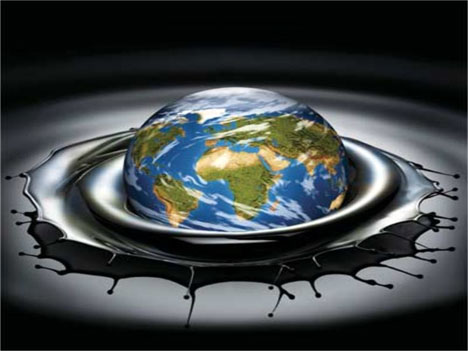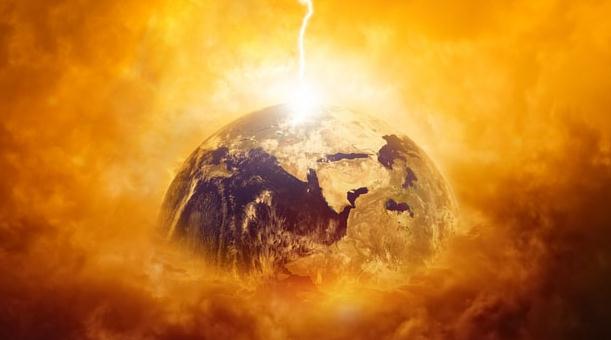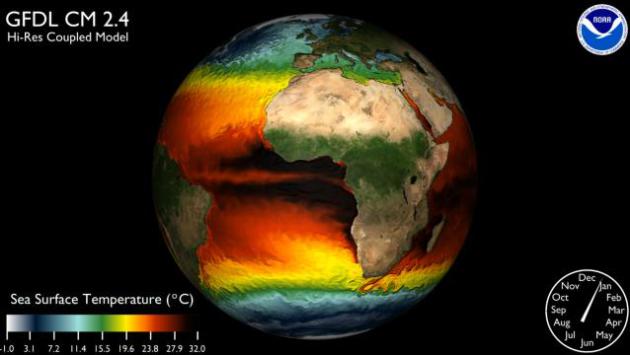18" snow at Blooming Prairie, Minnesota yesterday
81 F. high reported in the Twin Cities on May 2, 2012.
Tulsa, Oklahoma saw a trace of snow yesterday - the latest snow on record.
Jaw-dropping Extremes
Just when you thought you'd seen everything,
along comes the Backwards Spring of 2013. 18" at Blooming Prairie,
Minnesota. On May 2. The Twin Cities dodged a bullet, but this event
will probably be the snowiest May snowstorm on record for Minnesota,
Wisconsin and Iowa.
Every morning I dial up the latest maps, afraid
what I may find next. Parts of California are on fire, while a rare May
freeze pushes into Texas; record floods washing out roads in Key West.
Many Midwestern counties went from drought to flood in less than 2
weeks. Head-snapping weather.
In spite of La Nina, 2012 was the 9th warmest
year, worldwide, on record. Record melting of Arctic ice last year may
be impacting the jet stream, the river of high-speed air sweeping the
globe - increasing the chance of blocking patterns, which can cause
weather to temporarily stall. The result? A high amplitude pattern -
more north/south swings in the jet stream capable of creating
"cut-off" lows that can stall. Giant atmospheric roadblocks. More
extremes.
The "stuck" storm over Missouri responsible for
record snows east of MSP will rotate rain into town later today &
Saturday. Expect 60F by Sunday; some 70s next week as spring returns.
Fishing Opener? A rather mild Saturday gives way to a cooler front by
Mother's Day; probably dry for Race For The Cure.
Better days ahead. It can only get better right?
Rochester, Minnesota photo credit upper left: AP Photo/Post-Bulletin, Ken Klotzbach.
Thousand Oaks, California photo credit upper right: AP Photo/Nick Ut.
It Can't Be May. Brenda Lamonica sent in these photos from Rochester, Minnesota. Surreal. Pic courtesy of WeatherNation TV.
Tree-Snapping Snows. HIgh water content (1 to 1.5"
liquid) created a very heavy, wet snow just east of the Twin Cities.
Heart-attack snow. Tony Barlow captured this photo in Hudson, Wisconsin
Thursday. That's how close we came to an almost unimaginable
weather-mess yesterday. Courtesy: WeatherNation TV.
A Very Close Call. Waking up to a pale-green lawn
Thursday morning was annoying (having predicting a coating to 2" the
night before), but I also felt pure relief. Can you imagine what a
nightmare 12-18" of snow would have been for the immediate metro area
yesterday? It was bad enough from Rochester to Owatonna and Red
Wing,with downed trees and powerlines, hundreds of traffic accidents -
all the result of concrete-like heavy, wet slush. 8" amounts were
reported in Dakota County from Farmington to Cottage Grove, 4" at Lake
Elmo. Here's an interactive map from
NOAA.
Jaw-Dropping "May"-hem: Fire & Ice, Snow & Flooding.
This pattern really is nothing short of remarkable; huge, sweeping
north/south sweeps of jet stream energy capable of erasing a drought in a
meteorological blink of an eye, or pulling an almost February-like
airmass southward, with snowy consequences. Here's today's edition of
WeatherNation TV's
Climate Matters: "
Is
it really May 2nd? Some Midwest cities saw more than a foot and a half
of snow. To the west super dry windy conditions are fueling wildfires
and to the Southeast ongoing rains are leading to flooding.
Meteorologist Paul Douglas has more on the May weather mayhem."
Ah, May In Iowa. Thanks to Iowa State for passing this one along, a comparison of May 2, 2012 with May 2, 2013. Go cyclones!
A Reason To Keep On Going.
Today will feel like March 3, but by Monday of next week it will look
and feel like spring again (and none of us will take warmth for granted
ever again). The ECMWF shows a drier day Sunday, with dry weather
spilling over into Monday and Tuesday; a few showers and T-storms
possible Wednesday as highs top 70. We cool off a little late next week
before warming into the 60s again on Saturday, probably the milder day
of the Fishing Opener/Mother's Day weekend.
Encouraging Trends.
The U.S. models are in fairly tight alignment, showing a warming trend
into next week; a good chance of 70-degree highs by midweek.
Mother's Day Preview.
Here is the 240 ECMWF forecast for next Sunday morning, May 12. It
shows a cooler front pushing south; highs in the 50s (north) - maybe low
60s Twin Cities metro. It's early, but if this forecast verifies it
would be dry and comfortably cool for Race For The Cure and brunch with
your favorite mom. Don't forget about mom.
Risk Of A Real Warm Front.
I'm not getting too excited just yet (we've been down this road
before), but GFS numbers show a chance of 80s by mid-May. One thing is
certain: we're going to have a cooler, wetter, stormier summer than last
year.
What Is Going On? Bill Holton writes: "
Paul,
please explain to readers WHY this is happening? Snow of this magnitude
has NEVER been seen in this part of the country in May, or anywhere in
the U.S. outside of the Rockies." Bill, snow east of the Rockies,
outside of higher terrain in New England, is exceedingly rare, yes - but
not totally unprecedented. What we're seeing is consistent with what
climate scientists have been predicting for 30 years. As northern
latitudes warm the north-south temperature contrast weakens, which
triggers a drop in jet stream winds - which become more unstable, with
greater north/south swings, what meteorologists call a "high amplitude"
pattern. When this happens warm, moist air can be transported unusually
far north (helping to rapidly ease drought and trigger record flooding),
while unusually cold air can sweep much farther south than usual,
sometimes "cutting off" from the main belt of westerly steering winds,
causing weather patterns to temporarily stall. In short, the weather has
a greater potential to become become stuck.
Proving cause and effect is difficult, at times impossible, but
talking with climate scientists there seems to be a strong causal
connection between more weather extremes and record warming taking place
in the Arctic. 90% of warming is going into the oceans, and some of
that warmth is showing up in the Arctic, which has lost 70-75% of its
ice volume in 50 years, reaching a record low in September, 2012. A
warming Arctic can displace the cold air that should be at the top of
the world farther south over Canada, Europe and Asia, setting the stage
for more extremes, more head-scratching "Black Swan" weather events.
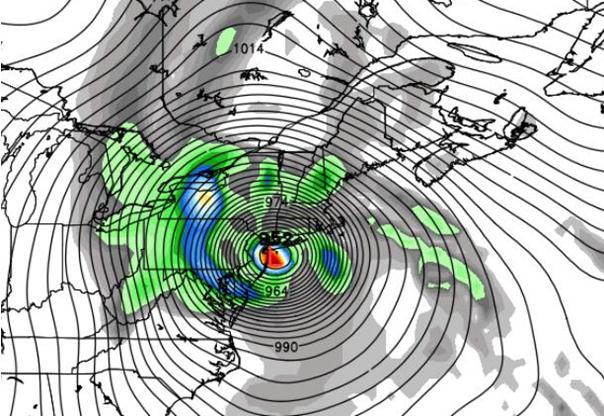
A blocking pattern (with a warm bubble of high pressure over
Greenland) steered Superstorm Sandy into coastal New Jersey on October
29, 2012, which is highly unusual for late October. A blocking pattern
resulted in blistering, record-setting heat over much of the USA last
summer. Droughts and heatwaves can become even more intense, while
(stalled) storms can squeeze out more rain, or snow. Keep in mind
there's more water vapor in the air (a 4% increase in 40 years), more
fuel for storms, summer and winter. Rain is falling harder during the
summer months, and when it does snow, it tends to come down harder.
There are few things more complicated and interconnected than weather
and climate - more research is required, but it's probably safe to say
that we'll see more extremes in the years ahead, more examples of
weather on steroids.
Changes in the Arctic are happening much faster than predicted.
Richard Alley at Penn State believes some of these changes are taking
place 100 years ahead of schedule. Climate scientist James Hansen
believes warming of the oceans and atmosphere is equivalent to 400,000
Hiroshima bombs going off every day. We may be undergoing a "phase
transition" in the climate system, which is non-linear. Nature rarely
moves in a straight line. Alarmist hype? I sure hope so. But the
reality: we're in uncharted water when it comes to global changes and
impact on local weather.
One Way To Break A Drought. The same extreme pattern
responsible for the 3rd snowiest April on record is tugging Gulf
moisture north. As of April 30 there is no more exceptional drought
across the state of Minnesota. moderate drought has dropped from 98% to
15% of the state since April 2, which is amazing. Southwest Minnesota
isn't entirely out of the woods, but if this pattern persists (likely)
most of Minnesota will be drought-free by the end of May. Thanks to Todd
Nelson at WeatherNation and the Minnesota State Climate Office.
Huge California Brushfire Spreads Over 6,500 Acres. Here's an excerpt from
Business Insider: "
Authorities have ordered the evacuation of hundreds of homes due to a brush fire in California, Reuters reports. According to CBS Los Angeles, the brush fire has consumed
around 6,500 acres of land along the U.S. 101 freeway near Camarillo
and Newbury Park in Ventura County, suburban areas to the northwest of
Los Angeles. The flames are being spread by high winds. ABC 10 News reports that more than 200 firefighters are tackling the blaze, with help from aircrafts dropping water and retardant. KTLA reports that the fire is "0% contained". There have been no reports of injuries so far..."
Photo credit above: REUTERS/Gene Blevins. "
A fast moving
brush fire approaches a home in the Camarillo Springs area of Ventura
County, California May 2, 2013. Southern California is under a high
fire alert due to high temperatures and high winds."
Low Tornado Numbers And Low Tornado Deaths: May 2012 - April 2013. Here's an excerpt from a
NOAA blog post that caught my eye: "...
The
death toll from May 2012-April 2013 was 7. National Weather Service
official statistics go back to January 1950, but we can extend that by
using the work of Tom Grazulis from the Tornado Project,
who has collected tornado fatality information back into the 17th
century. The data are reasonably good back to 1875, but it’s still
possible that there are some missed fatalities, particularly as we go
back farther in time. So, where does 7 fatalities in 12 consecutive
calendar months stack up? Again, here are the lowest totals, going back
to 1875, for 12 consecutive months, with the starting month."
Allergies On The Rise In U.S. Kids, Government Study Finds. Here's an excerpt from
NBC News: "
Allergies
triggered by food or the environment have risen sharply in U.S.
children in recent years, especially among more affluent families,
according to a large government study. The "epidemic" rise in allergies,
as one expert describes it, is of concern because it increases the
risk of potentially fatal respiratory diseases or disfiguring skin
conditions that could require long-term care. The latest data, released
on Thursday by the Centers for Disease Control, showed the prevalence
of food allergies increased in children under age 18 from 3.4 percent
in 1997 to 5.1 percent in 2011. Skin allergies rose from 7.4 percent to
12.5 percent in the same time period..."
Could You Go 1 Year Without The Internet? This Guy Did. Here's a fascinating tale from
The Verge.
Paul Miller went 365 days without logging onto the Internet. Was he
better for it? Here's an excerpt of a very readable story: "
I was
wrong. One year ago I left the internet. I thought it was making me
unproductive. I thought it lacked meaning. I thought it was "corrupting
my soul." It's a been a year now since I "surfed the web" or "checked
my email" or "liked" anything with a figurative rather than literal
thumbs up. I've managed to stay disconnected, just like I planned. I'm
internet free. And now I'm supposed to tell you how it solved all my
problems. I'm supposed to be enlightened. I'm supposed to be more
"real," now. More perfect. But instead it's 8PM and I just woke up. I
slept all day, woke with eight voicemails on my phone from friends and
coworkers. I went to my coffee shop to consume dinner, the Knicks game,
my two newspapers, and a copy of The New Yorker. And now I'm watching
Toy Story while I glance occasionally at the blinking cursor in this
text document, willing it to write itself, willing it to generate the
epiphanies my life has failed to produce. I didn't want to meet this
Paul at the tail end of my yearlong journey..."
Giant Rubber Duck Sails Into Hong Kong. Here's one headline I never thought I would read in the
Wall Street Journal. Photo courtesy of Bobby Yip and Reuters. Wow.
Trying To Keep Our Sense Of Humor. Someone down in
Fort Dodge, Iowa has a very good sense of humor, a snowman standing
guard over (inviting) waters at the town's swimming pool. Either you
laugh...or you weep. Not much in-between.
Climate Stories...
2012 Was The 9th Warmest Year, Worldwide, Since 1850. Here's an excerpt from a story at
Huffington Post: "
The
World Meteorological Organization says last year was the ninth-warmest
since record-keeping began in 1850, despite the cooling effect of the
weather pattern called La Nina. The U.N.'s weather agency says this
marks the 27th year in a row the global average temperature — 58
degrees Fahrenheit (14.45 degrees Celsius) in 2012 — surpassed the
1961-1990 average. WMO said in annual climate report Thursday the years
from 2001 to 2012 were all among the top 13 warmest on record."
Most Americans Blame Global Warming For Extreme Weather.
Climate change, "global weirding", call it what you want, but it's not
your grandfather's weather pattern anymore, as reported in this story at
LiveScience: "
More
than half of Americans think global warming is affecting weather in
the United States, according to a new nationally representative survey
that measures the pulse of American sentiment on climate change. The
newly released study shows that about two out of three Americans say
weather in the country has worsened over the past several years, with
only one in 10 saying the weather has been improving. Americans also
have strong views about the link between global warming and extreme weather..." (Photo: David Fine, FEMA).
Unburnable Fuel: Either Governments Are Not Serious About Climate Change Or Fossil Fuel Firms Are Overvalued. Here's an excerpt from a story at
The Economist: "
MARKETS
can misprice risk, as investors in subprime mortgages discovered in
2008. Several recent reports suggest that markets are now overlooking
the risk of “unburnable carbon”. The share prices of oil, gas and coal
companies depend in part on their reserves. The more fossil fuels a
firm has underground, the more valuable its shares. But what if some of
those reserves can never be dug up and burned?..."
Belief In Biblical End Times Stifling Climate Change Action In The U.S. - Study. Eric Dolan at
rawstory.com has the story; here's the intro: "
The
United States has failed to take action to mitigate climate change
thanks in part to the large number of religious Americans who believe
the world has a set expiration date. Research by David C. Barker of the
University of Pittsburgh and David H. Bearce of the University of
Colorado uncovered that belief in the biblical end-times was a
motivating factor behind resistance to curbing climate change. “[T]he
fact that such an overwhelming percentage of Republican citizens
profess a belief in the Second Coming (76 percent in 2006, according to
our sample) suggests that governmental attempts to curb greenhouse
emissions would encounter stiff resistance even if every Democrat in
the country wanted to curb them,” Barker and Bearce wrote in their
study, which will be published in the June issue of Political Science Quarterly..."
Top Investors Will Feel Heat Of New Epoch. Here's an excerpt of an Eric Roston article at
Bloomberg: "...
Modeling
climate economics is tricky, even more so than climate science is, if
that's possible. The former simplifies the latter and then combines it
with additional hard-to-know variables, like consumption, population
and energy use. All of these estimates end up in what climate wonks
call the “social cost of carbon,” or the estimated cost of future
damages, in today’s dollars, per ton of carbon dioxide. Policy analysts
use this estimate when scoring proposed regulations that affect
greenhouse gas emissions one way or another. Not including it would
imply that damages from carbon dioxide emissions aren't expected at
all; that's desirable, but it isn't true. The climate economics debate,
as it occurs in journals, news media and the blogosphere, turns on the
assumptions that economists pick when they translate future growth and
climate damages into today’s dollars. Often at issue is time
discounting. The more activist economists say that a high discount rate
carries implicit moral judgments, in that it discriminates against
future generations -- which have the same legal and moral value as we do
-- by sticking them with the costs of dealing with climate change..."



